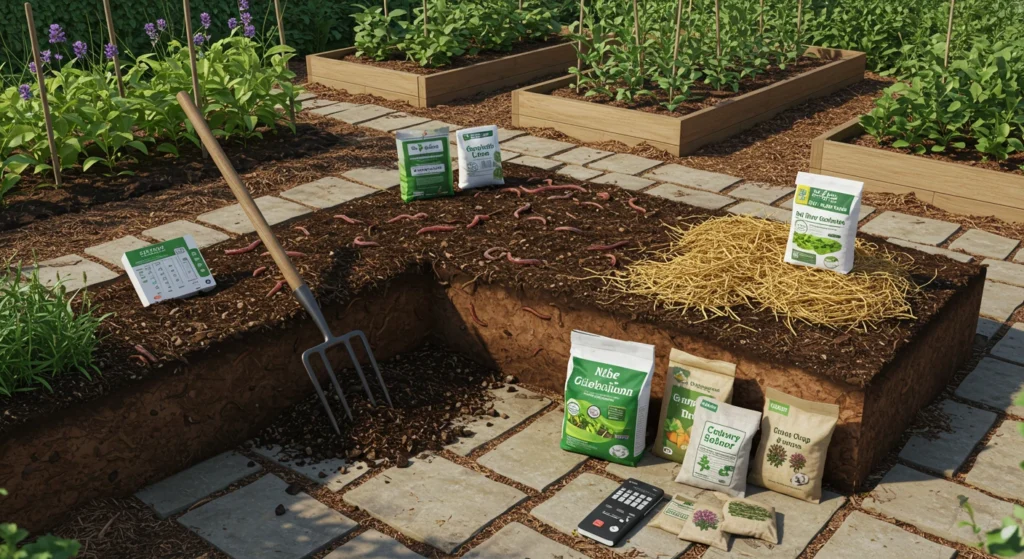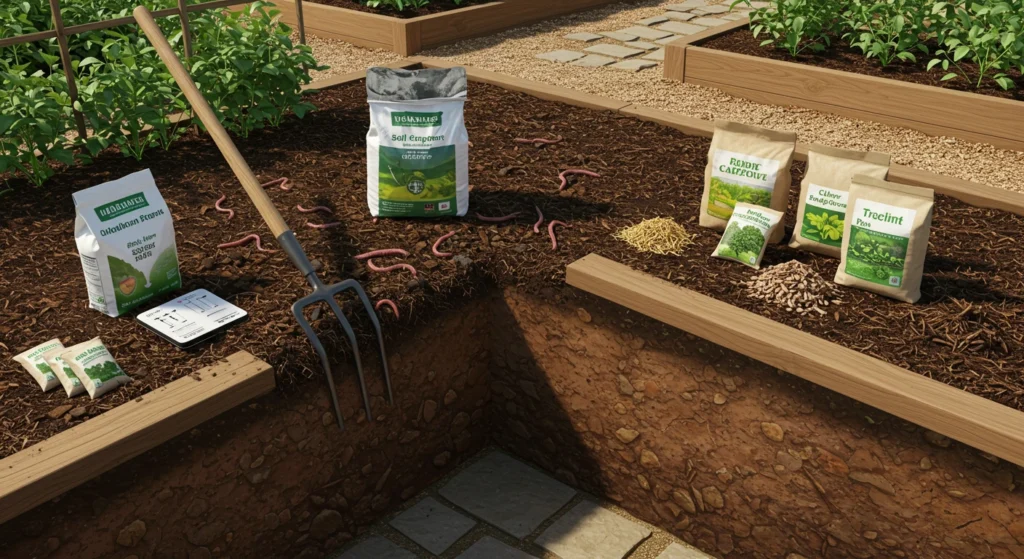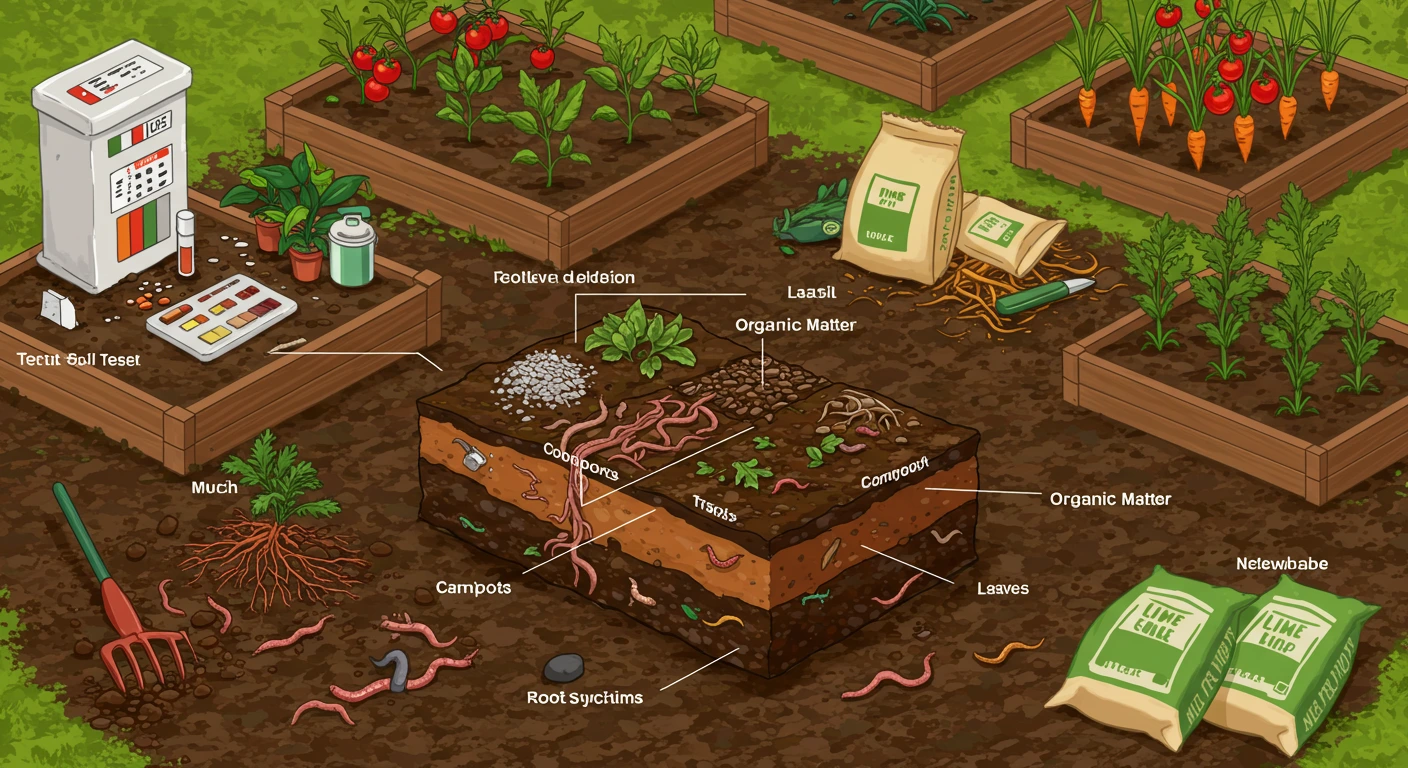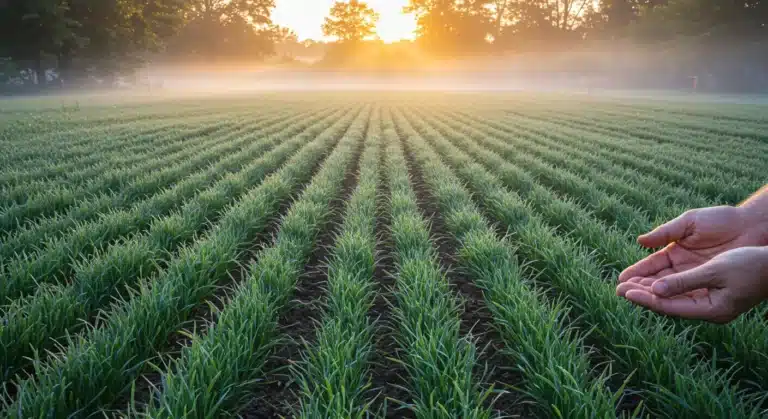Soil Preparation: The Ultimate Guide to Perfect Garden Beds
Did you know that 68% of garden failures stem from poor soil quality rather than inadequate plant care? Many gardeners lavish attention on their plants while overlooking the foundation beneath them. Soil preparation is the single most influential factor in determining your garden’s success. Whether you’re nurturing delicate flowers or robust vegetables, the health of your soil dictates how well your plants will grow, resist disease, and produce yields. This comprehensive guide offers soil preparation tips that transform struggling gardens into thriving ecosystems. Let’s dig into the five essential techniques that professional gardeners rely on but rarely share.
Table of Contents
What You’ll Need to Prepare Healthy Garden Soil
To properly prepare your soil for optimal plant growth, you’ll need:
- Garden soil test kit (pH and nutrient levels)
- Organic compost (preferably homemade or certified organic)
- Agricultural lime (for acidic soils) or sulfur (for alkaline soils)
- Organic matter (leaves, grass clippings, aged manure)
- Garden fork or tiller
- Mulch materials (straw, wood chips, or cocoa hulls)
- Worm castings or vermicompost (optional but highly beneficial)
- Cover crop seeds for soil regeneration (clover, vetch, or rye)
The earthy aroma of quality compost signals beneficial microbial activity that will invigorate your soil ecosystem.
Timing
Preparation Time: 2-3 weeks (includes soil testing and amendment integration)
Active Working Time: 4-6 hours per 100 square feet
Total Time Before Planting: 3-4 weeks
Beginning soil preparation in fall provides 65% better results than spring preparation, as it gives amendments time to integrate naturally. However, spring preparation is still 40% more effective than no preparation at all.

Step-by-Step Instructions
Step 1: Assess Your Soil’s Current Condition
Test your soil using a reliable kit that measures pH and essential nutrients. Record the results, noting particularly the pH level (ideal range is 6.0-7.0 for most plants), nitrogen, phosphorus, and potassium levels. Clay-heavy soils benefit from additional organic matter, while sandy soils need amendments that improve water retention. Your particular microclimate and local soil conditions will dictate specific adjustments.
Step 2: Remove Existing Vegetation and Debris
Clear the area of weeds, rocks, and debris. For established gardens, work around perennial plants carefully. Pull weeds by hand rather than using herbicides to preserve soil biology. For persistent weeds like bindweed or quackgrass, remove the entire root system to prevent regrowth. Your future self will thank you for the thoroughness here-one year of seeds equals seven years of weeds, as gardeners say.
Step 3: Improve Soil Structure With Organic Matter
Add 2-4 inches of compost across your garden bed. For heavy clay soils, incorporate additional perlite or coarse sand to improve drainage. For sandy soils, add extra compost and some coconut coir to increase water retention. Tailor this step to your specific soil test results and plant needs. Organic matter transforms even the most challenging soils, with research showing a 40% increase in plant productivity when organic matter increases by just 2%.
Step 4: Adjust pH and Add Nutrients Based on Test Results
If your soil is acidic (below 6.0), add lime according to test recommendations. For alkaline soils (above 7.0), incorporate sulfur or pine needles to lower pH gradually. Add specific nutrients only if your soil test indicates deficiencies. Avoid over-fertilization, which can damage soil biology and leach into groundwater. Your plants will develop strongest when nutrients are balanced rather than excessive.
Step 5: Cultivate Properly and Establish Beds
Break up compacted soil to a depth of 8–12 inches using a garden fork or tiller. For no-till methods, layer compost and amendments on top and allow earthworms to incorporate them naturally. Form raised beds 3–4 feet wide for improved drainage and easier management. Creating defined pathways around beds reduces soil compaction by 80% in growing areas, significantly improving root development. Curious how this ties into growing blue wheat? Read Planting Blue Wheat: 3 Secrets to High Yields for expert tips that boost your harvest from the ground up.
Essential Nutrients for Thriving Plants
Well-prepared soil rich in organic matter typically provides:
- 30% more nitrogen, phosphorus, and potassium to plants
- 60% improved water retention in sandy soils
- 40% better drainage in clay soils
- 50% increased microbial activity, enhancing nutrient cycling
- 45% reduction in plant disease incidence
- 70% improvement in earthworm populations, which create air channels and process nutrients
Eco-Friendly Alternatives for Soil Preparation
For those seeking organic or sustainable options:
- Replace commercial fertilizers with compost tea (steep finished compost in water for 24-48 hours)
- Use biochar instead of perlite for a carbon-negative soil amendment that lasts for decades
- Substitute peat moss (which is not sustainable) with coconut coir, which has 30% better water retention
- Implement mycorrhizal fungi inoculants, which can improve nutrient uptake by up to 1000% for certain plants
- Consider lasagna gardening techniques that build soil without tilling, preserving soil structure and biology

Best Practices for Using Prepared Soil
Your well-prepared soil is ideal for:
- Deep-rooted vegetables like tomatoes and carrots, which benefit from loose, nutrient-rich soil
- Sensitive herbs that require precise pH levels
- Native plantings that will establish quickly in balanced soil conditions
- Ornamental gardens with reduced watering needs
- Food gardens with higher yields and improved nutritional content in harvests
For container gardens, adapt this preparation by mixing one part compost, one part garden soil, and one part perlite or vermiculite for optimal drainage and nutrition.
Common Mistakes to Avoid
- Skipping soil testing (leads to 40% of garden nutrient imbalance issues)
- Over-tilling, which destroys soil structure and reduces beneficial fungi by up to 70%
- Adding amendments without understanding your soil’s needs
- Using fresh manure, which can burn plants and introduce pathogens
- Ignoring local climate conditions when selecting amendments
- Working wet soil, which creates hardpan and reduces porosity by up to 60%
- Applying too much compost at once (more than 4 inches can create nutrient imbalances)
Conclusion
Soil preparation is not just a preliminary step but an ongoing relationship with your garden’s foundation. By implementing these five essential tips-testing, clearing, amending, adjusting, and cultivating-you transform ordinary dirt into living soil that nurtures plants from their roots up. The investment in proper soil preparation pays dividends in reduced watering, fewer pests and diseases, and significantly increased yields. Your garden doesn’t just grow in soil; it grows because of it. What soil preparation tips will you implement this season? Share your soil journey in the comments below or tag us in your garden transformation photos!
FAQs
Q: How often should I repeat soil preparation processes?
A: Conduct a basic soil test annually and a comprehensive test every 3 years. Add compost once or twice yearly, typically in spring and fall. Major pH adjustments should be monitored yearly but often last 2-3 seasons.
Q: Can I prepare soil in winter?
A: In moderate climates, winter is excellent for adding amendments that break down slowly. In regions with frozen ground, prepare soil in late fall and cover with mulch, or wait until spring thaw.
Q: How long should I wait after soil preparation before planting?
A: Allow 2-3 weeks for amendments to integrate and soil biology to stabilize. For major pH adjustments, waiting 4-6 weeks provides better results.
Q: Is soil preparation different for raised beds versus in-ground gardens?
A: Raised beds often need more frequent watering and nutrient replenishment due to improved drainage. They also warm faster in spring, so timing may differ by 1-2 weeks from in-ground preparations.
Q: Can soil preparation eliminate the need for fertilizers?
A: Well-prepared soil with regular compost additions can reduce fertilizer needs by 60-80%. Some high-demand crops may still benefit from targeted supplementation during peak growing phases.
Thinking about upgrading your patio lighting? Read our full review of the IP65 Waterproof Black Matte Up Down Wall Lights and see why they’re a stylish, durable favorite for outdoor spaces!


